Organizational Change Management: Power, Culture, and Leadership
VerifiedAdded on 2020/05/11
|12
|2915
|363
Essay
AI Summary
This essay delves into the complexities of organizational change management, examining the interplay of power dynamics, cultural influences, and leadership strategies. It begins by defining organizational change and its various drivers, including technological advancements, economic shifts, and consumer demands, while also acknowledging the impact of government policies and regulations. The essay then focuses on the critical roles of power and politics within organizations, highlighting the significance of positive power in boosting productivity and employee decision-making, as well as the importance of navigating workplace politics. It explores how different national cultures, particularly those of Singapore and Australia, influence the acceptance and application of power in change management, referencing Hofstede's cultural dimensions to illustrate these variations. The study analyzes the five bases of power established by French and Raven, including legitimate, reward, expert, referent, and coercive powers, and examines their positive and negative effects on the change management process. The essay further investigates the impact of Hofstede’s cultural dimensions on these powers and provides a comparative analysis of change management approaches in Singapore and Australia, considering factors such as power distance, individualism, masculinity, uncertainty avoidance, and long-term orientation. The work concludes by emphasizing the importance of aligning change initiatives with organizational and national cultures for effective and sustainable outcomes, particularly in the context of different cultural values.

Running head: ORGANIZATIONAL CHANGE
Manage Organizational Change
Name of the Student:
Name of the University:
Author’s Note:
Manage Organizational Change
Name of the Student:
Name of the University:
Author’s Note:
Paraphrase This Document
Need a fresh take? Get an instant paraphrase of this document with our AI Paraphraser
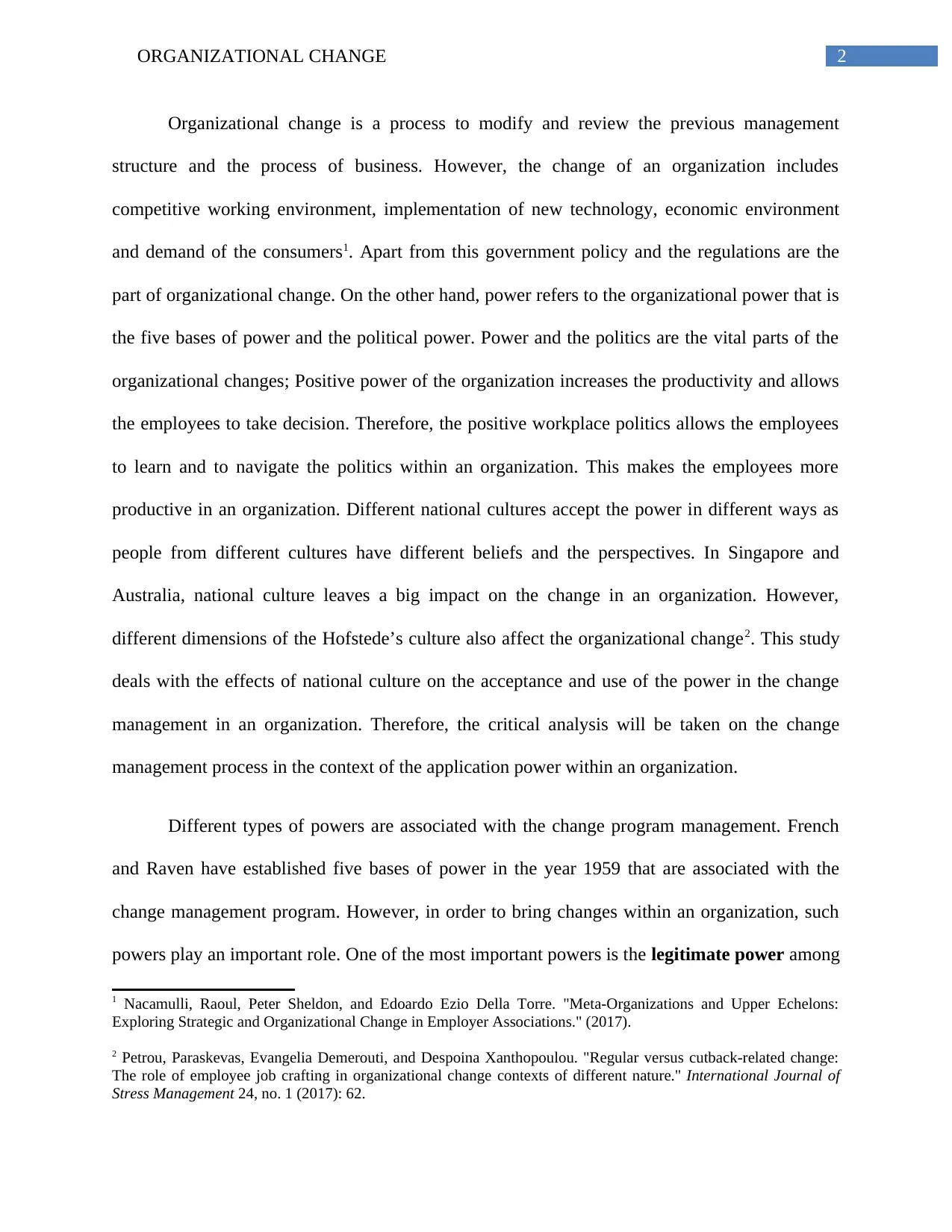
2ORGANIZATIONAL CHANGE
Organizational change is a process to modify and review the previous management
structure and the process of business. However, the change of an organization includes
competitive working environment, implementation of new technology, economic environment
and demand of the consumers1. Apart from this government policy and the regulations are the
part of organizational change. On the other hand, power refers to the organizational power that is
the five bases of power and the political power. Power and the politics are the vital parts of the
organizational changes; Positive power of the organization increases the productivity and allows
the employees to take decision. Therefore, the positive workplace politics allows the employees
to learn and to navigate the politics within an organization. This makes the employees more
productive in an organization. Different national cultures accept the power in different ways as
people from different cultures have different beliefs and the perspectives. In Singapore and
Australia, national culture leaves a big impact on the change in an organization. However,
different dimensions of the Hofstede’s culture also affect the organizational change2. This study
deals with the effects of national culture on the acceptance and use of the power in the change
management in an organization. Therefore, the critical analysis will be taken on the change
management process in the context of the application power within an organization.
Different types of powers are associated with the change program management. French
and Raven have established five bases of power in the year 1959 that are associated with the
change management program. However, in order to bring changes within an organization, such
powers play an important role. One of the most important powers is the legitimate power among
1 Nacamulli, Raoul, Peter Sheldon, and Edoardo Ezio Della Torre. "Meta-Organizations and Upper Echelons:
Exploring Strategic and Organizational Change in Employer Associations." (2017).
2 Petrou, Paraskevas, Evangelia Demerouti, and Despoina Xanthopoulou. "Regular versus cutback-related change:
The role of employee job crafting in organizational change contexts of different nature." International Journal of
Stress Management 24, no. 1 (2017): 62.
Organizational change is a process to modify and review the previous management
structure and the process of business. However, the change of an organization includes
competitive working environment, implementation of new technology, economic environment
and demand of the consumers1. Apart from this government policy and the regulations are the
part of organizational change. On the other hand, power refers to the organizational power that is
the five bases of power and the political power. Power and the politics are the vital parts of the
organizational changes; Positive power of the organization increases the productivity and allows
the employees to take decision. Therefore, the positive workplace politics allows the employees
to learn and to navigate the politics within an organization. This makes the employees more
productive in an organization. Different national cultures accept the power in different ways as
people from different cultures have different beliefs and the perspectives. In Singapore and
Australia, national culture leaves a big impact on the change in an organization. However,
different dimensions of the Hofstede’s culture also affect the organizational change2. This study
deals with the effects of national culture on the acceptance and use of the power in the change
management in an organization. Therefore, the critical analysis will be taken on the change
management process in the context of the application power within an organization.
Different types of powers are associated with the change program management. French
and Raven have established five bases of power in the year 1959 that are associated with the
change management program. However, in order to bring changes within an organization, such
powers play an important role. One of the most important powers is the legitimate power among
1 Nacamulli, Raoul, Peter Sheldon, and Edoardo Ezio Della Torre. "Meta-Organizations and Upper Echelons:
Exploring Strategic and Organizational Change in Employer Associations." (2017).
2 Petrou, Paraskevas, Evangelia Demerouti, and Despoina Xanthopoulou. "Regular versus cutback-related change:
The role of employee job crafting in organizational change contexts of different nature." International Journal of
Stress Management 24, no. 1 (2017): 62.
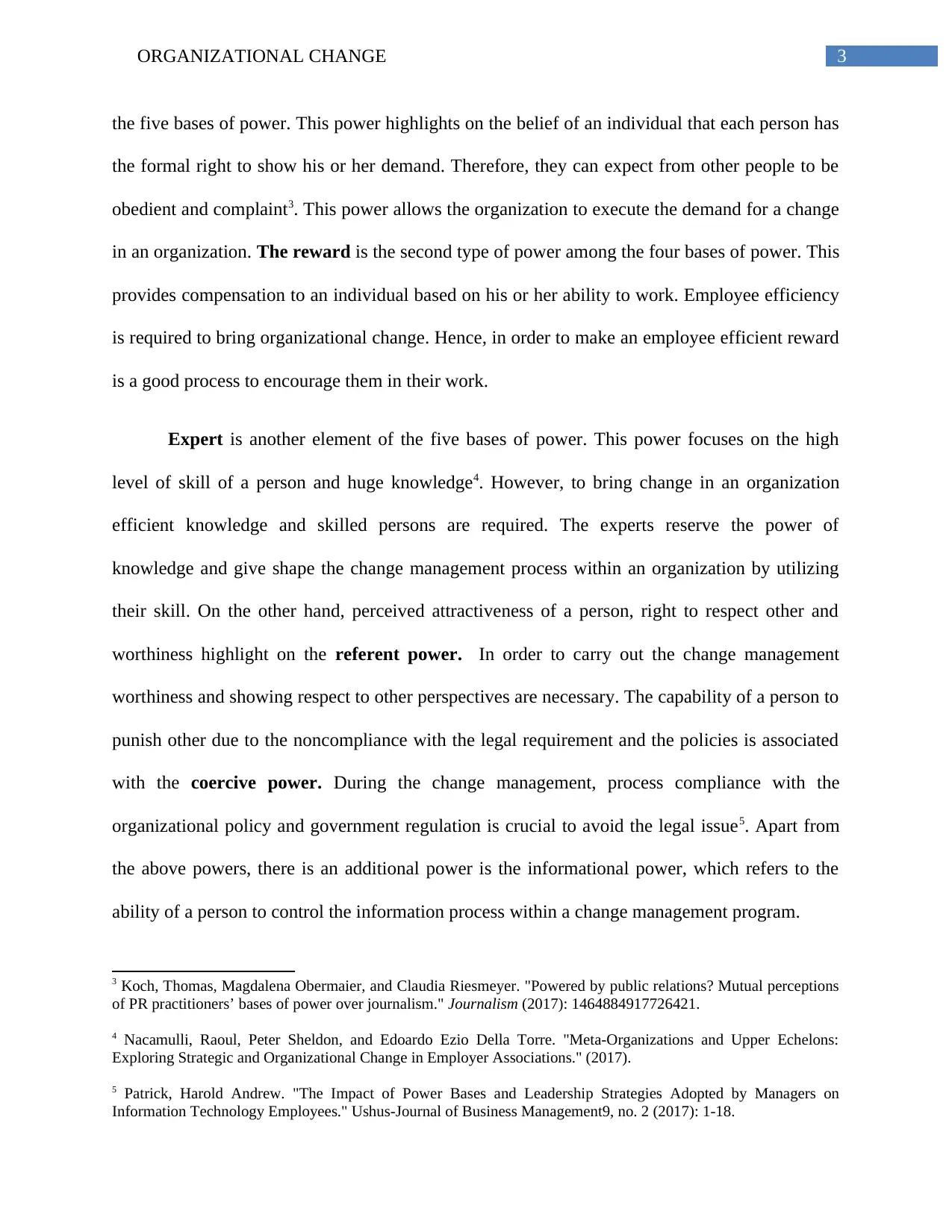
3ORGANIZATIONAL CHANGE
the five bases of power. This power highlights on the belief of an individual that each person has
the formal right to show his or her demand. Therefore, they can expect from other people to be
obedient and complaint3. This power allows the organization to execute the demand for a change
in an organization. The reward is the second type of power among the four bases of power. This
provides compensation to an individual based on his or her ability to work. Employee efficiency
is required to bring organizational change. Hence, in order to make an employee efficient reward
is a good process to encourage them in their work.
Expert is another element of the five bases of power. This power focuses on the high
level of skill of a person and huge knowledge4. However, to bring change in an organization
efficient knowledge and skilled persons are required. The experts reserve the power of
knowledge and give shape the change management process within an organization by utilizing
their skill. On the other hand, perceived attractiveness of a person, right to respect other and
worthiness highlight on the referent power. In order to carry out the change management
worthiness and showing respect to other perspectives are necessary. The capability of a person to
punish other due to the noncompliance with the legal requirement and the policies is associated
with the coercive power. During the change management, process compliance with the
organizational policy and government regulation is crucial to avoid the legal issue5. Apart from
the above powers, there is an additional power is the informational power, which refers to the
ability of a person to control the information process within a change management program.
3 Koch, Thomas, Magdalena Obermaier, and Claudia Riesmeyer. "Powered by public relations? Mutual perceptions
of PR practitioners’ bases of power over journalism." Journalism (2017): 1464884917726421.
4 Nacamulli, Raoul, Peter Sheldon, and Edoardo Ezio Della Torre. "Meta-Organizations and Upper Echelons:
Exploring Strategic and Organizational Change in Employer Associations." (2017).
5 Patrick, Harold Andrew. "The Impact of Power Bases and Leadership Strategies Adopted by Managers on
Information Technology Employees." Ushus-Journal of Business Management9, no. 2 (2017): 1-18.
the five bases of power. This power highlights on the belief of an individual that each person has
the formal right to show his or her demand. Therefore, they can expect from other people to be
obedient and complaint3. This power allows the organization to execute the demand for a change
in an organization. The reward is the second type of power among the four bases of power. This
provides compensation to an individual based on his or her ability to work. Employee efficiency
is required to bring organizational change. Hence, in order to make an employee efficient reward
is a good process to encourage them in their work.
Expert is another element of the five bases of power. This power focuses on the high
level of skill of a person and huge knowledge4. However, to bring change in an organization
efficient knowledge and skilled persons are required. The experts reserve the power of
knowledge and give shape the change management process within an organization by utilizing
their skill. On the other hand, perceived attractiveness of a person, right to respect other and
worthiness highlight on the referent power. In order to carry out the change management
worthiness and showing respect to other perspectives are necessary. The capability of a person to
punish other due to the noncompliance with the legal requirement and the policies is associated
with the coercive power. During the change management, process compliance with the
organizational policy and government regulation is crucial to avoid the legal issue5. Apart from
the above powers, there is an additional power is the informational power, which refers to the
ability of a person to control the information process within a change management program.
3 Koch, Thomas, Magdalena Obermaier, and Claudia Riesmeyer. "Powered by public relations? Mutual perceptions
of PR practitioners’ bases of power over journalism." Journalism (2017): 1464884917726421.
4 Nacamulli, Raoul, Peter Sheldon, and Edoardo Ezio Della Torre. "Meta-Organizations and Upper Echelons:
Exploring Strategic and Organizational Change in Employer Associations." (2017).
5 Patrick, Harold Andrew. "The Impact of Power Bases and Leadership Strategies Adopted by Managers on
Information Technology Employees." Ushus-Journal of Business Management9, no. 2 (2017): 1-18.
⊘ This is a preview!⊘
Do you want full access?
Subscribe today to unlock all pages.

Trusted by 1+ million students worldwide
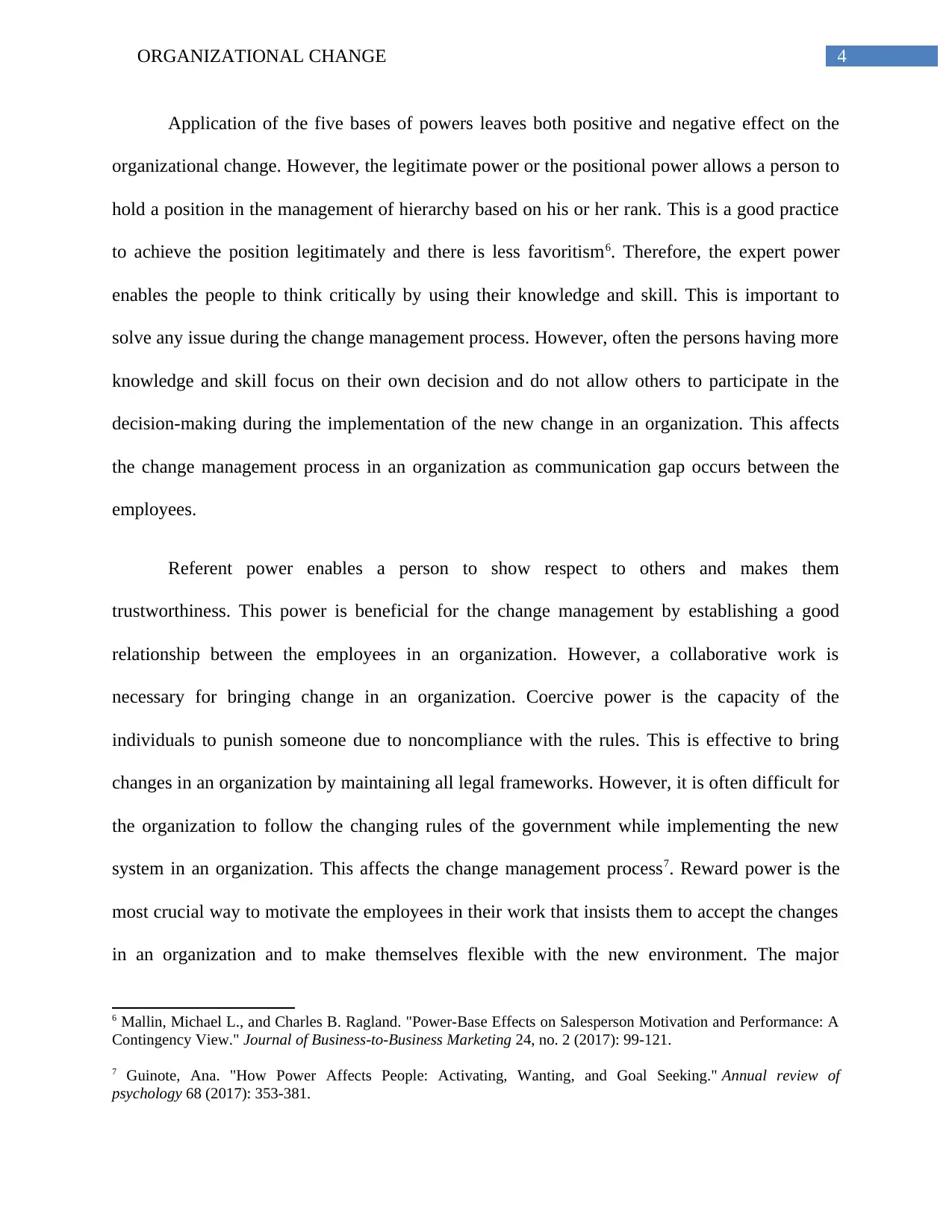
4ORGANIZATIONAL CHANGE
Application of the five bases of powers leaves both positive and negative effect on the
organizational change. However, the legitimate power or the positional power allows a person to
hold a position in the management of hierarchy based on his or her rank. This is a good practice
to achieve the position legitimately and there is less favoritism6. Therefore, the expert power
enables the people to think critically by using their knowledge and skill. This is important to
solve any issue during the change management process. However, often the persons having more
knowledge and skill focus on their own decision and do not allow others to participate in the
decision-making during the implementation of the new change in an organization. This affects
the change management process in an organization as communication gap occurs between the
employees.
Referent power enables a person to show respect to others and makes them
trustworthiness. This power is beneficial for the change management by establishing a good
relationship between the employees in an organization. However, a collaborative work is
necessary for bringing change in an organization. Coercive power is the capacity of the
individuals to punish someone due to noncompliance with the rules. This is effective to bring
changes in an organization by maintaining all legal frameworks. However, it is often difficult for
the organization to follow the changing rules of the government while implementing the new
system in an organization. This affects the change management process7. Reward power is the
most crucial way to motivate the employees in their work that insists them to accept the changes
in an organization and to make themselves flexible with the new environment. The major
6 Mallin, Michael L., and Charles B. Ragland. "Power-Base Effects on Salesperson Motivation and Performance: A
Contingency View." Journal of Business-to-Business Marketing 24, no. 2 (2017): 99-121.
7 Guinote, Ana. "How Power Affects People: Activating, Wanting, and Goal Seeking." Annual review of
psychology 68 (2017): 353-381.
Application of the five bases of powers leaves both positive and negative effect on the
organizational change. However, the legitimate power or the positional power allows a person to
hold a position in the management of hierarchy based on his or her rank. This is a good practice
to achieve the position legitimately and there is less favoritism6. Therefore, the expert power
enables the people to think critically by using their knowledge and skill. This is important to
solve any issue during the change management process. However, often the persons having more
knowledge and skill focus on their own decision and do not allow others to participate in the
decision-making during the implementation of the new change in an organization. This affects
the change management process in an organization as communication gap occurs between the
employees.
Referent power enables a person to show respect to others and makes them
trustworthiness. This power is beneficial for the change management by establishing a good
relationship between the employees in an organization. However, a collaborative work is
necessary for bringing change in an organization. Coercive power is the capacity of the
individuals to punish someone due to noncompliance with the rules. This is effective to bring
changes in an organization by maintaining all legal frameworks. However, it is often difficult for
the organization to follow the changing rules of the government while implementing the new
system in an organization. This affects the change management process7. Reward power is the
most crucial way to motivate the employees in their work that insists them to accept the changes
in an organization and to make themselves flexible with the new environment. The major
6 Mallin, Michael L., and Charles B. Ragland. "Power-Base Effects on Salesperson Motivation and Performance: A
Contingency View." Journal of Business-to-Business Marketing 24, no. 2 (2017): 99-121.
7 Guinote, Ana. "How Power Affects People: Activating, Wanting, and Goal Seeking." Annual review of
psychology 68 (2017): 353-381.
Paraphrase This Document
Need a fresh take? Get an instant paraphrase of this document with our AI Paraphraser

5ORGANIZATIONAL CHANGE
drawback of this reward program is it often creates jealousy between the employees and
discrimination.
Hofstede’s cultural dimension refers to a framework of the cross cultural communication
process. However, the value of a society culture on its members is the basic element of such
theory. Power distance index refers to the belief that allows the individuals to accept the equal
distribution of the power. Therefore, individualism vs the collectivism index highlights on the
integration of the people in a group within a society8. A tight integration and establishment of the
good relationship is the main element of such dimensions. Uncertainty avoidance index is
another component of this culture, which focuses on the tolerance level of the society for
ambiguity. In this dimension, individuals avert an event, which is unexpected or totally new for
them. Masculinity vs femininity is another dimension of this theory. In this dimension, the
masculinity refers to a preferable position in a society. However, in a masculine society, the
women are empathetic in nature but more than the men are.
Long-term vs short-term orientation highlights on the connection between the past and
the present. The country, which is short-term oriented is economically week while the long-term
oriented country gets continuous development. Restraint vs indulgence index focuses on the
fulfillment of the happiness. Indulgence is a society that allows the human being to exhibit their
desires and to enjoy9. On the other hand, restraint refers to a society where the gratification is
under control. Such cultural dimension reveals a difference between the cultural values.
8 Pfajfar, Gregor, Aviv Shoham, Maja Makovec Brenčič, Dimitrios Koufopoulos, Constantine S. Katsikeas, and
Maciej Mitręga. "Power source drivers and performance outcomes of functional and dysfunctional conflict in
exporter–importer relationships." Industrial Marketing Management (2017).
9 Berlin, Cecilia, W. Patrick Neumann, Nancy Theberge, and Roland Örtengren. "‘Power base’tactics for workplace
change–an interview study with industrial engineers and ergonomists." Ergonomics 60, no. 5 (2017): 613-627.
drawback of this reward program is it often creates jealousy between the employees and
discrimination.
Hofstede’s cultural dimension refers to a framework of the cross cultural communication
process. However, the value of a society culture on its members is the basic element of such
theory. Power distance index refers to the belief that allows the individuals to accept the equal
distribution of the power. Therefore, individualism vs the collectivism index highlights on the
integration of the people in a group within a society8. A tight integration and establishment of the
good relationship is the main element of such dimensions. Uncertainty avoidance index is
another component of this culture, which focuses on the tolerance level of the society for
ambiguity. In this dimension, individuals avert an event, which is unexpected or totally new for
them. Masculinity vs femininity is another dimension of this theory. In this dimension, the
masculinity refers to a preferable position in a society. However, in a masculine society, the
women are empathetic in nature but more than the men are.
Long-term vs short-term orientation highlights on the connection between the past and
the present. The country, which is short-term oriented is economically week while the long-term
oriented country gets continuous development. Restraint vs indulgence index focuses on the
fulfillment of the happiness. Indulgence is a society that allows the human being to exhibit their
desires and to enjoy9. On the other hand, restraint refers to a society where the gratification is
under control. Such cultural dimension reveals a difference between the cultural values.
8 Pfajfar, Gregor, Aviv Shoham, Maja Makovec Brenčič, Dimitrios Koufopoulos, Constantine S. Katsikeas, and
Maciej Mitręga. "Power source drivers and performance outcomes of functional and dysfunctional conflict in
exporter–importer relationships." Industrial Marketing Management (2017).
9 Berlin, Cecilia, W. Patrick Neumann, Nancy Theberge, and Roland Örtengren. "‘Power base’tactics for workplace
change–an interview study with industrial engineers and ergonomists." Ergonomics 60, no. 5 (2017): 613-627.
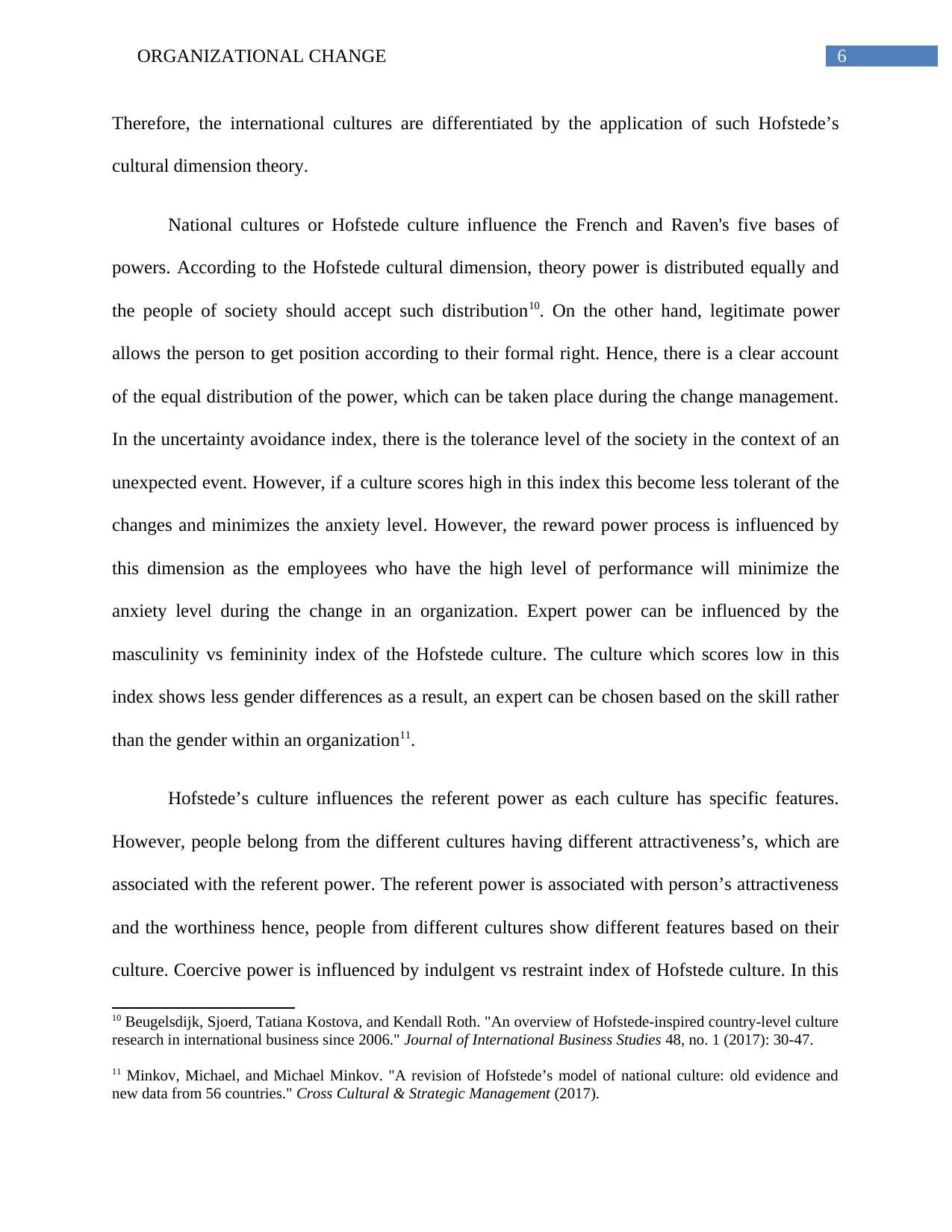
6ORGANIZATIONAL CHANGE
Therefore, the international cultures are differentiated by the application of such Hofstede’s
cultural dimension theory.
National cultures or Hofstede culture influence the French and Raven's five bases of
powers. According to the Hofstede cultural dimension, theory power is distributed equally and
the people of society should accept such distribution10. On the other hand, legitimate power
allows the person to get position according to their formal right. Hence, there is a clear account
of the equal distribution of the power, which can be taken place during the change management.
In the uncertainty avoidance index, there is the tolerance level of the society in the context of an
unexpected event. However, if a culture scores high in this index this become less tolerant of the
changes and minimizes the anxiety level. However, the reward power process is influenced by
this dimension as the employees who have the high level of performance will minimize the
anxiety level during the change in an organization. Expert power can be influenced by the
masculinity vs femininity index of the Hofstede culture. The culture which scores low in this
index shows less gender differences as a result, an expert can be chosen based on the skill rather
than the gender within an organization11.
Hofstede’s culture influences the referent power as each culture has specific features.
However, people belong from the different cultures having different attractiveness’s, which are
associated with the referent power. The referent power is associated with person’s attractiveness
and the worthiness hence, people from different cultures show different features based on their
culture. Coercive power is influenced by indulgent vs restraint index of Hofstede culture. In this
10 Beugelsdijk, Sjoerd, Tatiana Kostova, and Kendall Roth. "An overview of Hofstede-inspired country-level culture
research in international business since 2006." Journal of International Business Studies 48, no. 1 (2017): 30-47.
11 Minkov, Michael, and Michael Minkov. "A revision of Hofstede’s model of national culture: old evidence and
new data from 56 countries." Cross Cultural & Strategic Management (2017).
Therefore, the international cultures are differentiated by the application of such Hofstede’s
cultural dimension theory.
National cultures or Hofstede culture influence the French and Raven's five bases of
powers. According to the Hofstede cultural dimension, theory power is distributed equally and
the people of society should accept such distribution10. On the other hand, legitimate power
allows the person to get position according to their formal right. Hence, there is a clear account
of the equal distribution of the power, which can be taken place during the change management.
In the uncertainty avoidance index, there is the tolerance level of the society in the context of an
unexpected event. However, if a culture scores high in this index this become less tolerant of the
changes and minimizes the anxiety level. However, the reward power process is influenced by
this dimension as the employees who have the high level of performance will minimize the
anxiety level during the change in an organization. Expert power can be influenced by the
masculinity vs femininity index of the Hofstede culture. The culture which scores low in this
index shows less gender differences as a result, an expert can be chosen based on the skill rather
than the gender within an organization11.
Hofstede’s culture influences the referent power as each culture has specific features.
However, people belong from the different cultures having different attractiveness’s, which are
associated with the referent power. The referent power is associated with person’s attractiveness
and the worthiness hence, people from different cultures show different features based on their
culture. Coercive power is influenced by indulgent vs restraint index of Hofstede culture. In this
10 Beugelsdijk, Sjoerd, Tatiana Kostova, and Kendall Roth. "An overview of Hofstede-inspired country-level culture
research in international business since 2006." Journal of International Business Studies 48, no. 1 (2017): 30-47.
11 Minkov, Michael, and Michael Minkov. "A revision of Hofstede’s model of national culture: old evidence and
new data from 56 countries." Cross Cultural & Strategic Management (2017).
⊘ This is a preview!⊘
Do you want full access?
Subscribe today to unlock all pages.

Trusted by 1+ million students worldwide
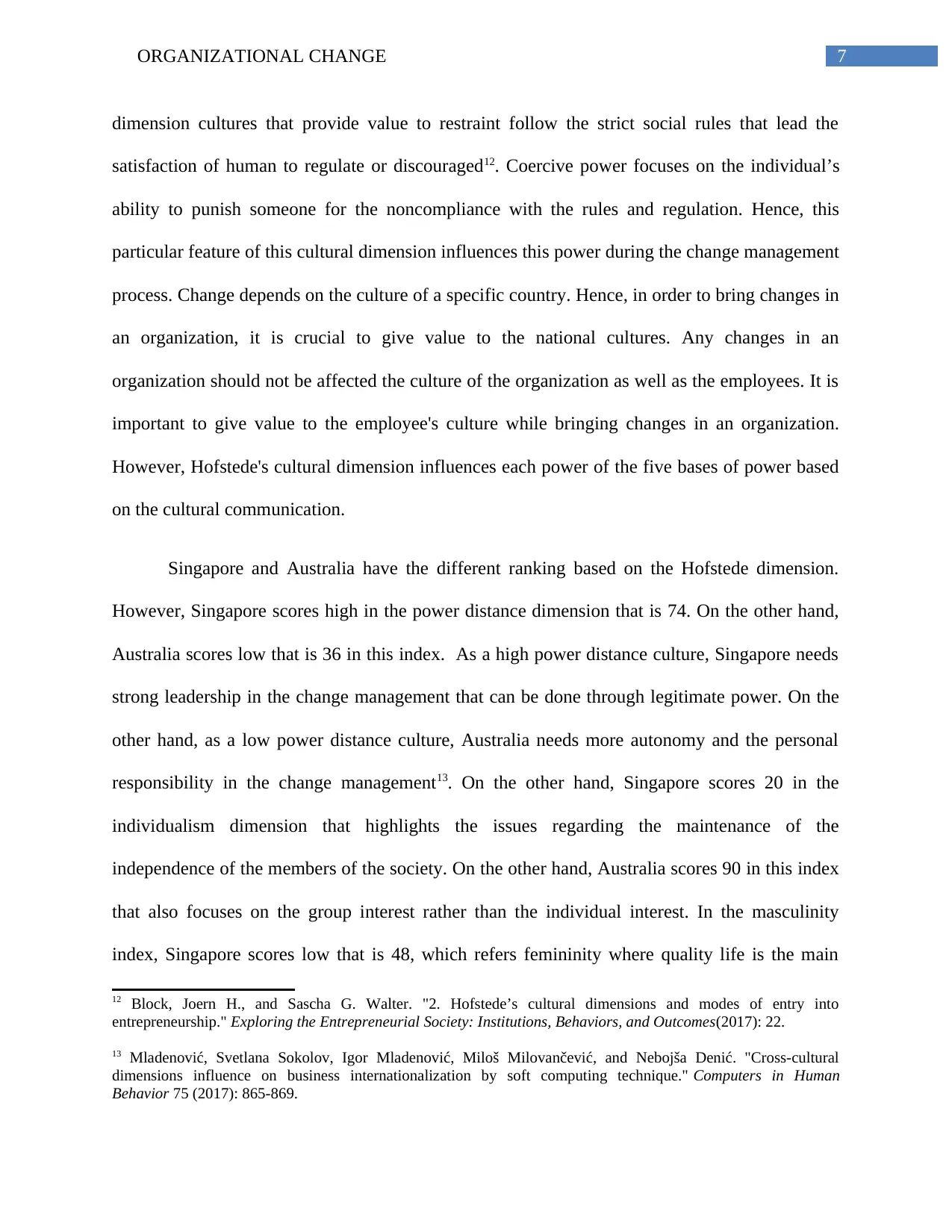
7ORGANIZATIONAL CHANGE
dimension cultures that provide value to restraint follow the strict social rules that lead the
satisfaction of human to regulate or discouraged12. Coercive power focuses on the individual’s
ability to punish someone for the noncompliance with the rules and regulation. Hence, this
particular feature of this cultural dimension influences this power during the change management
process. Change depends on the culture of a specific country. Hence, in order to bring changes in
an organization, it is crucial to give value to the national cultures. Any changes in an
organization should not be affected the culture of the organization as well as the employees. It is
important to give value to the employee's culture while bringing changes in an organization.
However, Hofstede's cultural dimension influences each power of the five bases of power based
on the cultural communication.
Singapore and Australia have the different ranking based on the Hofstede dimension.
However, Singapore scores high in the power distance dimension that is 74. On the other hand,
Australia scores low that is 36 in this index. As a high power distance culture, Singapore needs
strong leadership in the change management that can be done through legitimate power. On the
other hand, as a low power distance culture, Australia needs more autonomy and the personal
responsibility in the change management13. On the other hand, Singapore scores 20 in the
individualism dimension that highlights the issues regarding the maintenance of the
independence of the members of the society. On the other hand, Australia scores 90 in this index
that also focuses on the group interest rather than the individual interest. In the masculinity
index, Singapore scores low that is 48, which refers femininity where quality life is the main
12 Block, Joern H., and Sascha G. Walter. "2. Hofstede’s cultural dimensions and modes of entry into
entrepreneurship." Exploring the Entrepreneurial Society: Institutions, Behaviors, and Outcomes(2017): 22.
13 Mladenović, Svetlana Sokolov, Igor Mladenović, Miloš Milovančević, and Nebojša Denić. "Cross-cultural
dimensions influence on business internationalization by soft computing technique." Computers in Human
Behavior 75 (2017): 865-869.
dimension cultures that provide value to restraint follow the strict social rules that lead the
satisfaction of human to regulate or discouraged12. Coercive power focuses on the individual’s
ability to punish someone for the noncompliance with the rules and regulation. Hence, this
particular feature of this cultural dimension influences this power during the change management
process. Change depends on the culture of a specific country. Hence, in order to bring changes in
an organization, it is crucial to give value to the national cultures. Any changes in an
organization should not be affected the culture of the organization as well as the employees. It is
important to give value to the employee's culture while bringing changes in an organization.
However, Hofstede's cultural dimension influences each power of the five bases of power based
on the cultural communication.
Singapore and Australia have the different ranking based on the Hofstede dimension.
However, Singapore scores high in the power distance dimension that is 74. On the other hand,
Australia scores low that is 36 in this index. As a high power distance culture, Singapore needs
strong leadership in the change management that can be done through legitimate power. On the
other hand, as a low power distance culture, Australia needs more autonomy and the personal
responsibility in the change management13. On the other hand, Singapore scores 20 in the
individualism dimension that highlights the issues regarding the maintenance of the
independence of the members of the society. On the other hand, Australia scores 90 in this index
that also focuses on the group interest rather than the individual interest. In the masculinity
index, Singapore scores low that is 48, which refers femininity where quality life is the main
12 Block, Joern H., and Sascha G. Walter. "2. Hofstede’s cultural dimensions and modes of entry into
entrepreneurship." Exploring the Entrepreneurial Society: Institutions, Behaviors, and Outcomes(2017): 22.
13 Mladenović, Svetlana Sokolov, Igor Mladenović, Miloš Milovančević, and Nebojša Denić. "Cross-cultural
dimensions influence on business internationalization by soft computing technique." Computers in Human
Behavior 75 (2017): 865-869.
Paraphrase This Document
Need a fresh take? Get an instant paraphrase of this document with our AI Paraphraser
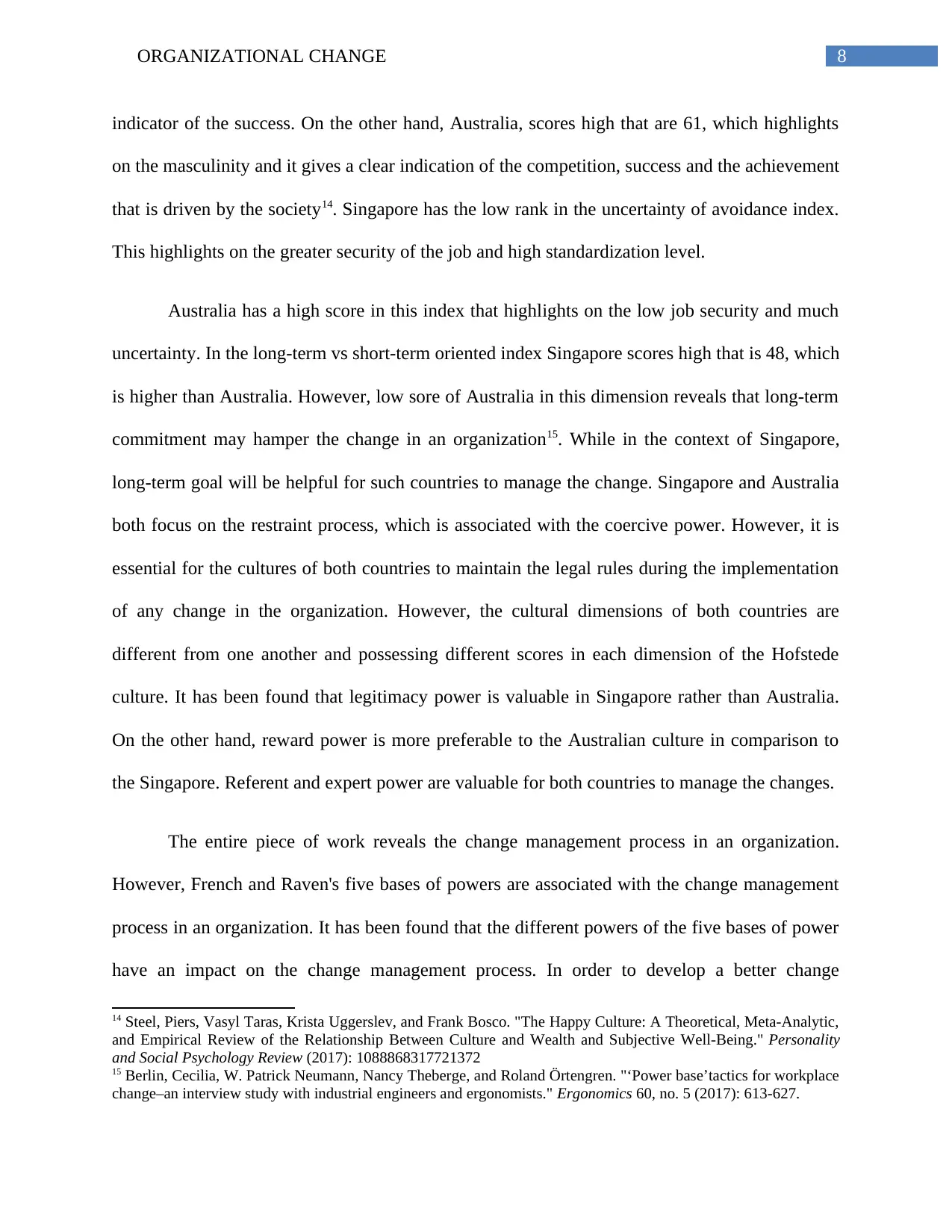
8ORGANIZATIONAL CHANGE
indicator of the success. On the other hand, Australia, scores high that are 61, which highlights
on the masculinity and it gives a clear indication of the competition, success and the achievement
that is driven by the society14. Singapore has the low rank in the uncertainty of avoidance index.
This highlights on the greater security of the job and high standardization level.
Australia has a high score in this index that highlights on the low job security and much
uncertainty. In the long-term vs short-term oriented index Singapore scores high that is 48, which
is higher than Australia. However, low sore of Australia in this dimension reveals that long-term
commitment may hamper the change in an organization15. While in the context of Singapore,
long-term goal will be helpful for such countries to manage the change. Singapore and Australia
both focus on the restraint process, which is associated with the coercive power. However, it is
essential for the cultures of both countries to maintain the legal rules during the implementation
of any change in the organization. However, the cultural dimensions of both countries are
different from one another and possessing different scores in each dimension of the Hofstede
culture. It has been found that legitimacy power is valuable in Singapore rather than Australia.
On the other hand, reward power is more preferable to the Australian culture in comparison to
the Singapore. Referent and expert power are valuable for both countries to manage the changes.
The entire piece of work reveals the change management process in an organization.
However, French and Raven's five bases of powers are associated with the change management
process in an organization. It has been found that the different powers of the five bases of power
have an impact on the change management process. In order to develop a better change
14 Steel, Piers, Vasyl Taras, Krista Uggerslev, and Frank Bosco. "The Happy Culture: A Theoretical, Meta-Analytic,
and Empirical Review of the Relationship Between Culture and Wealth and Subjective Well-Being." Personality
and Social Psychology Review (2017): 1088868317721372
15 Berlin, Cecilia, W. Patrick Neumann, Nancy Theberge, and Roland Örtengren. "‘Power base’tactics for workplace
change–an interview study with industrial engineers and ergonomists." Ergonomics 60, no. 5 (2017): 613-627.
indicator of the success. On the other hand, Australia, scores high that are 61, which highlights
on the masculinity and it gives a clear indication of the competition, success and the achievement
that is driven by the society14. Singapore has the low rank in the uncertainty of avoidance index.
This highlights on the greater security of the job and high standardization level.
Australia has a high score in this index that highlights on the low job security and much
uncertainty. In the long-term vs short-term oriented index Singapore scores high that is 48, which
is higher than Australia. However, low sore of Australia in this dimension reveals that long-term
commitment may hamper the change in an organization15. While in the context of Singapore,
long-term goal will be helpful for such countries to manage the change. Singapore and Australia
both focus on the restraint process, which is associated with the coercive power. However, it is
essential for the cultures of both countries to maintain the legal rules during the implementation
of any change in the organization. However, the cultural dimensions of both countries are
different from one another and possessing different scores in each dimension of the Hofstede
culture. It has been found that legitimacy power is valuable in Singapore rather than Australia.
On the other hand, reward power is more preferable to the Australian culture in comparison to
the Singapore. Referent and expert power are valuable for both countries to manage the changes.
The entire piece of work reveals the change management process in an organization.
However, French and Raven's five bases of powers are associated with the change management
process in an organization. It has been found that the different powers of the five bases of power
have an impact on the change management process. In order to develop a better change
14 Steel, Piers, Vasyl Taras, Krista Uggerslev, and Frank Bosco. "The Happy Culture: A Theoretical, Meta-Analytic,
and Empirical Review of the Relationship Between Culture and Wealth and Subjective Well-Being." Personality
and Social Psychology Review (2017): 1088868317721372
15 Berlin, Cecilia, W. Patrick Neumann, Nancy Theberge, and Roland Örtengren. "‘Power base’tactics for workplace
change–an interview study with industrial engineers and ergonomists." Ergonomics 60, no. 5 (2017): 613-627.

9ORGANIZATIONAL CHANGE
management process, it is important to comply with the rules and regulation of the organization
and the government by addressing coercive power. Legitimate power is helpful for the
individuals to get position according to their right16. Expert power focuses on the knowledge
distribution during the change management while referent power is associated with the
worthiness. Reward powers play a great role to motivate the employees to accept the change.
From this study, it has been received that national cultures or the Hofstede’s dimensional theory
influence the five bases of powers in relation to change management17. On the other hand, A
comparison of the power-related Hofstede's culture in the context of Singapore and Australia
also addressed. Based on the scores of different dimensions of Hofstede culture power bases are
identified in Australia and Singapore.
16 Minkov, Michael, Michael Minkov, Pinaki Dutt, Pinaki Dutt, Michael Schachner, Michael Schachner, Oswaldo
Morales et al. "A revision of Hofstede’s individualism-collectivism dimension: A new national index from a 56-
country study." Cross-Cultural & Strategic Management 24, no. 3 (2017): 386-404.
17 Guinote, Ana. "How Power Affects People: Activating, Wanting, and Goal Seeking." Annual review of
psychology 68 (2017): 353-381.
management process, it is important to comply with the rules and regulation of the organization
and the government by addressing coercive power. Legitimate power is helpful for the
individuals to get position according to their right16. Expert power focuses on the knowledge
distribution during the change management while referent power is associated with the
worthiness. Reward powers play a great role to motivate the employees to accept the change.
From this study, it has been received that national cultures or the Hofstede’s dimensional theory
influence the five bases of powers in relation to change management17. On the other hand, A
comparison of the power-related Hofstede's culture in the context of Singapore and Australia
also addressed. Based on the scores of different dimensions of Hofstede culture power bases are
identified in Australia and Singapore.
16 Minkov, Michael, Michael Minkov, Pinaki Dutt, Pinaki Dutt, Michael Schachner, Michael Schachner, Oswaldo
Morales et al. "A revision of Hofstede’s individualism-collectivism dimension: A new national index from a 56-
country study." Cross-Cultural & Strategic Management 24, no. 3 (2017): 386-404.
17 Guinote, Ana. "How Power Affects People: Activating, Wanting, and Goal Seeking." Annual review of
psychology 68 (2017): 353-381.
⊘ This is a preview!⊘
Do you want full access?
Subscribe today to unlock all pages.

Trusted by 1+ million students worldwide
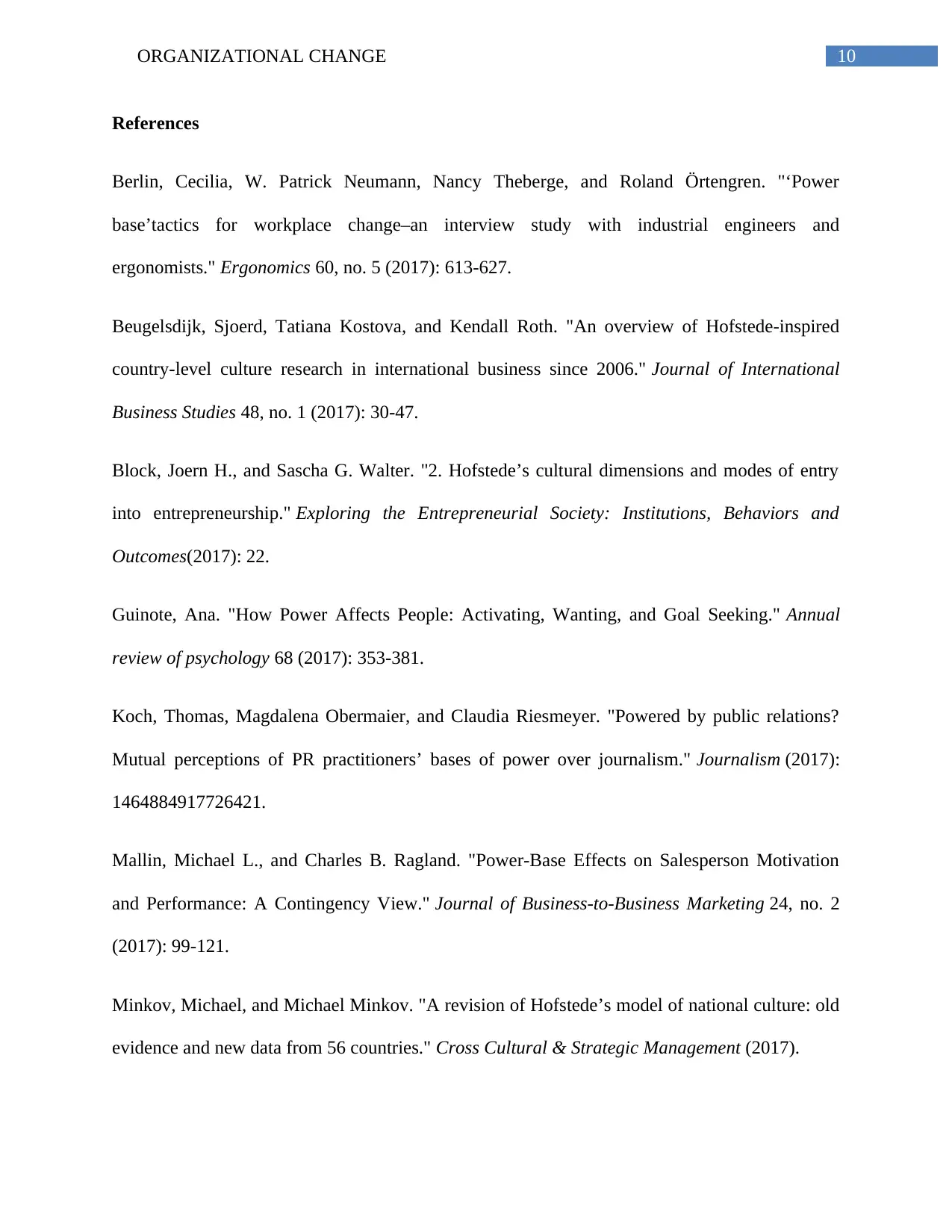
10ORGANIZATIONAL CHANGE
References
Berlin, Cecilia, W. Patrick Neumann, Nancy Theberge, and Roland Örtengren. "‘Power
base’tactics for workplace change–an interview study with industrial engineers and
ergonomists." Ergonomics 60, no. 5 (2017): 613-627.
Beugelsdijk, Sjoerd, Tatiana Kostova, and Kendall Roth. "An overview of Hofstede-inspired
country-level culture research in international business since 2006." Journal of International
Business Studies 48, no. 1 (2017): 30-47.
Block, Joern H., and Sascha G. Walter. "2. Hofstede’s cultural dimensions and modes of entry
into entrepreneurship." Exploring the Entrepreneurial Society: Institutions, Behaviors and
Outcomes(2017): 22.
Guinote, Ana. "How Power Affects People: Activating, Wanting, and Goal Seeking." Annual
review of psychology 68 (2017): 353-381.
Koch, Thomas, Magdalena Obermaier, and Claudia Riesmeyer. "Powered by public relations?
Mutual perceptions of PR practitioners’ bases of power over journalism." Journalism (2017):
1464884917726421.
Mallin, Michael L., and Charles B. Ragland. "Power-Base Effects on Salesperson Motivation
and Performance: A Contingency View." Journal of Business-to-Business Marketing 24, no. 2
(2017): 99-121.
Minkov, Michael, and Michael Minkov. "A revision of Hofstede’s model of national culture: old
evidence and new data from 56 countries." Cross Cultural & Strategic Management (2017).
References
Berlin, Cecilia, W. Patrick Neumann, Nancy Theberge, and Roland Örtengren. "‘Power
base’tactics for workplace change–an interview study with industrial engineers and
ergonomists." Ergonomics 60, no. 5 (2017): 613-627.
Beugelsdijk, Sjoerd, Tatiana Kostova, and Kendall Roth. "An overview of Hofstede-inspired
country-level culture research in international business since 2006." Journal of International
Business Studies 48, no. 1 (2017): 30-47.
Block, Joern H., and Sascha G. Walter. "2. Hofstede’s cultural dimensions and modes of entry
into entrepreneurship." Exploring the Entrepreneurial Society: Institutions, Behaviors and
Outcomes(2017): 22.
Guinote, Ana. "How Power Affects People: Activating, Wanting, and Goal Seeking." Annual
review of psychology 68 (2017): 353-381.
Koch, Thomas, Magdalena Obermaier, and Claudia Riesmeyer. "Powered by public relations?
Mutual perceptions of PR practitioners’ bases of power over journalism." Journalism (2017):
1464884917726421.
Mallin, Michael L., and Charles B. Ragland. "Power-Base Effects on Salesperson Motivation
and Performance: A Contingency View." Journal of Business-to-Business Marketing 24, no. 2
(2017): 99-121.
Minkov, Michael, and Michael Minkov. "A revision of Hofstede’s model of national culture: old
evidence and new data from 56 countries." Cross Cultural & Strategic Management (2017).
Paraphrase This Document
Need a fresh take? Get an instant paraphrase of this document with our AI Paraphraser
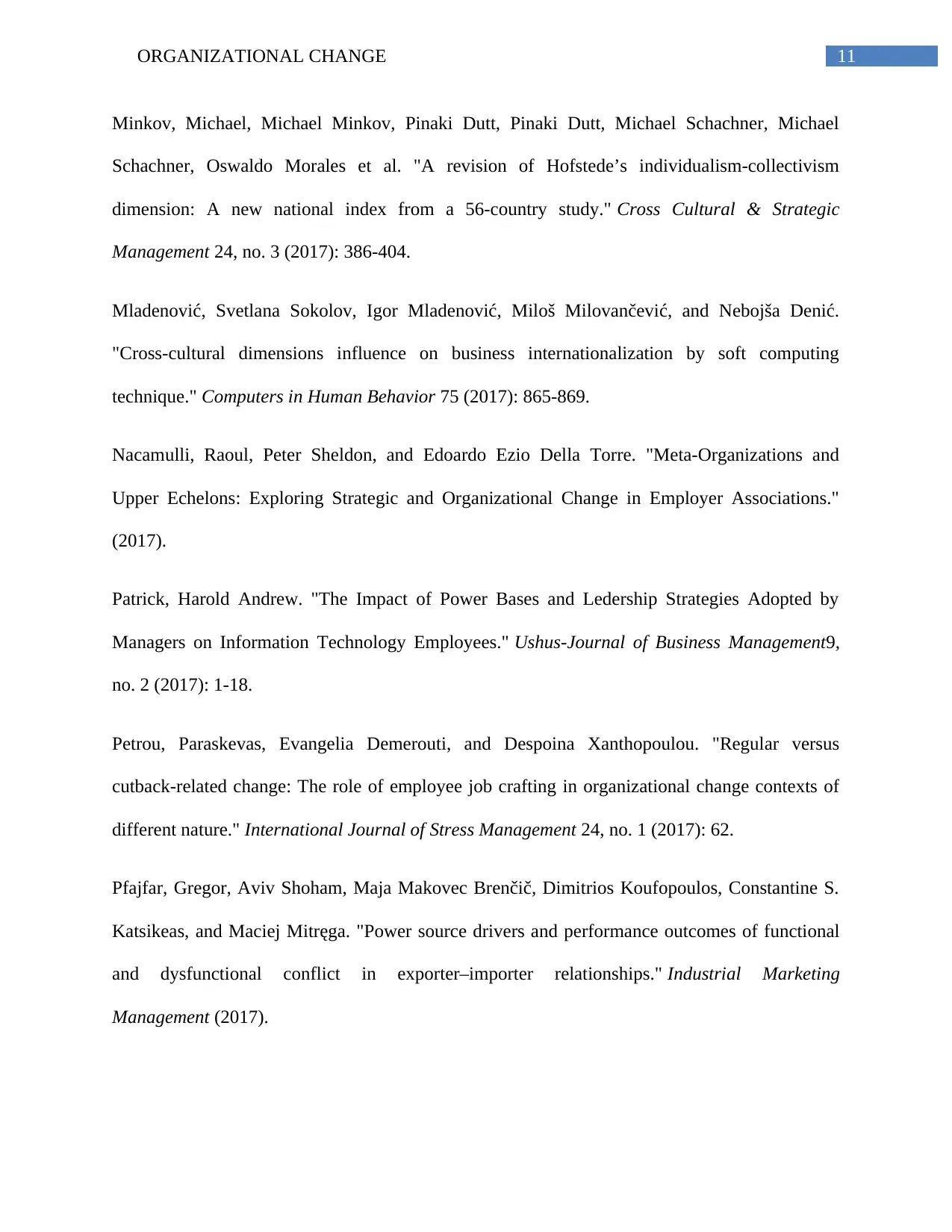
11ORGANIZATIONAL CHANGE
Minkov, Michael, Michael Minkov, Pinaki Dutt, Pinaki Dutt, Michael Schachner, Michael
Schachner, Oswaldo Morales et al. "A revision of Hofstede’s individualism-collectivism
dimension: A new national index from a 56-country study." Cross Cultural & Strategic
Management 24, no. 3 (2017): 386-404.
Mladenović, Svetlana Sokolov, Igor Mladenović, Miloš Milovančević, and Nebojša Denić.
"Cross-cultural dimensions influence on business internationalization by soft computing
technique." Computers in Human Behavior 75 (2017): 865-869.
Nacamulli, Raoul, Peter Sheldon, and Edoardo Ezio Della Torre. "Meta-Organizations and
Upper Echelons: Exploring Strategic and Organizational Change in Employer Associations."
(2017).
Patrick, Harold Andrew. "The Impact of Power Bases and Ledership Strategies Adopted by
Managers on Information Technology Employees." Ushus-Journal of Business Management9,
no. 2 (2017): 1-18.
Petrou, Paraskevas, Evangelia Demerouti, and Despoina Xanthopoulou. "Regular versus
cutback-related change: The role of employee job crafting in organizational change contexts of
different nature." International Journal of Stress Management 24, no. 1 (2017): 62.
Pfajfar, Gregor, Aviv Shoham, Maja Makovec Brenčič, Dimitrios Koufopoulos, Constantine S.
Katsikeas, and Maciej Mitręga. "Power source drivers and performance outcomes of functional
and dysfunctional conflict in exporter–importer relationships." Industrial Marketing
Management (2017).
Minkov, Michael, Michael Minkov, Pinaki Dutt, Pinaki Dutt, Michael Schachner, Michael
Schachner, Oswaldo Morales et al. "A revision of Hofstede’s individualism-collectivism
dimension: A new national index from a 56-country study." Cross Cultural & Strategic
Management 24, no. 3 (2017): 386-404.
Mladenović, Svetlana Sokolov, Igor Mladenović, Miloš Milovančević, and Nebojša Denić.
"Cross-cultural dimensions influence on business internationalization by soft computing
technique." Computers in Human Behavior 75 (2017): 865-869.
Nacamulli, Raoul, Peter Sheldon, and Edoardo Ezio Della Torre. "Meta-Organizations and
Upper Echelons: Exploring Strategic and Organizational Change in Employer Associations."
(2017).
Patrick, Harold Andrew. "The Impact of Power Bases and Ledership Strategies Adopted by
Managers on Information Technology Employees." Ushus-Journal of Business Management9,
no. 2 (2017): 1-18.
Petrou, Paraskevas, Evangelia Demerouti, and Despoina Xanthopoulou. "Regular versus
cutback-related change: The role of employee job crafting in organizational change contexts of
different nature." International Journal of Stress Management 24, no. 1 (2017): 62.
Pfajfar, Gregor, Aviv Shoham, Maja Makovec Brenčič, Dimitrios Koufopoulos, Constantine S.
Katsikeas, and Maciej Mitręga. "Power source drivers and performance outcomes of functional
and dysfunctional conflict in exporter–importer relationships." Industrial Marketing
Management (2017).
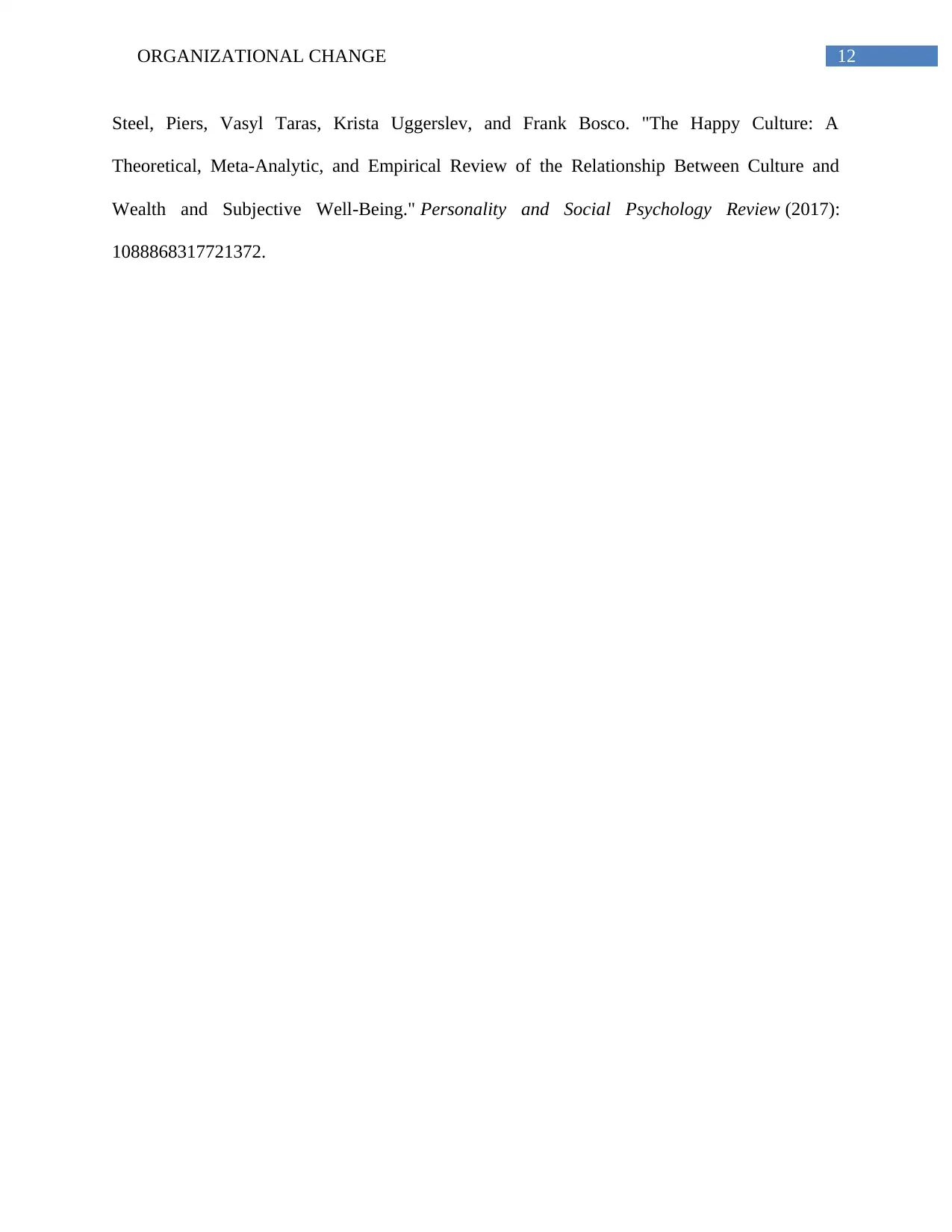
12ORGANIZATIONAL CHANGE
Steel, Piers, Vasyl Taras, Krista Uggerslev, and Frank Bosco. "The Happy Culture: A
Theoretical, Meta-Analytic, and Empirical Review of the Relationship Between Culture and
Wealth and Subjective Well-Being." Personality and Social Psychology Review (2017):
1088868317721372.
Steel, Piers, Vasyl Taras, Krista Uggerslev, and Frank Bosco. "The Happy Culture: A
Theoretical, Meta-Analytic, and Empirical Review of the Relationship Between Culture and
Wealth and Subjective Well-Being." Personality and Social Psychology Review (2017):
1088868317721372.
⊘ This is a preview!⊘
Do you want full access?
Subscribe today to unlock all pages.

Trusted by 1+ million students worldwide
1 out of 12
Related Documents
Your All-in-One AI-Powered Toolkit for Academic Success.
+13062052269
info@desklib.com
Available 24*7 on WhatsApp / Email
![[object Object]](/_next/static/media/star-bottom.7253800d.svg)
Unlock your academic potential
Copyright © 2020–2025 A2Z Services. All Rights Reserved. Developed and managed by ZUCOL.





